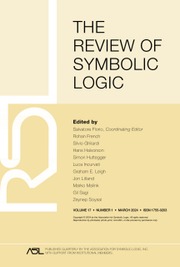Crossref Citations
This article has been cited by the following publications. This list is generated based on data provided by Crossref.
Rivello, Edoardo
2019.
Revision Without Revision Sequences: Self-Referential Truth.
Journal of Philosophical Logic,
Vol. 48,
Issue. 3,
p.
523.
ROSSI, LORENZO
2019.
A UNIFIED THEORY OF TRUTH AND PARADOX.
The Review of Symbolic Logic,
Vol. 12,
Issue. 2,
p.
209.
Rivello, Edoardo
2019.
Revision Without Revision Sequences: Circular Definitions.
Journal of Philosophical Logic,
Vol. 48,
Issue. 1,
p.
57.
Hansen, Casper Storm
2021.
Founding Mathematics on Semantic Conventions.
Vol. 446,
Issue. ,
p.
113.

